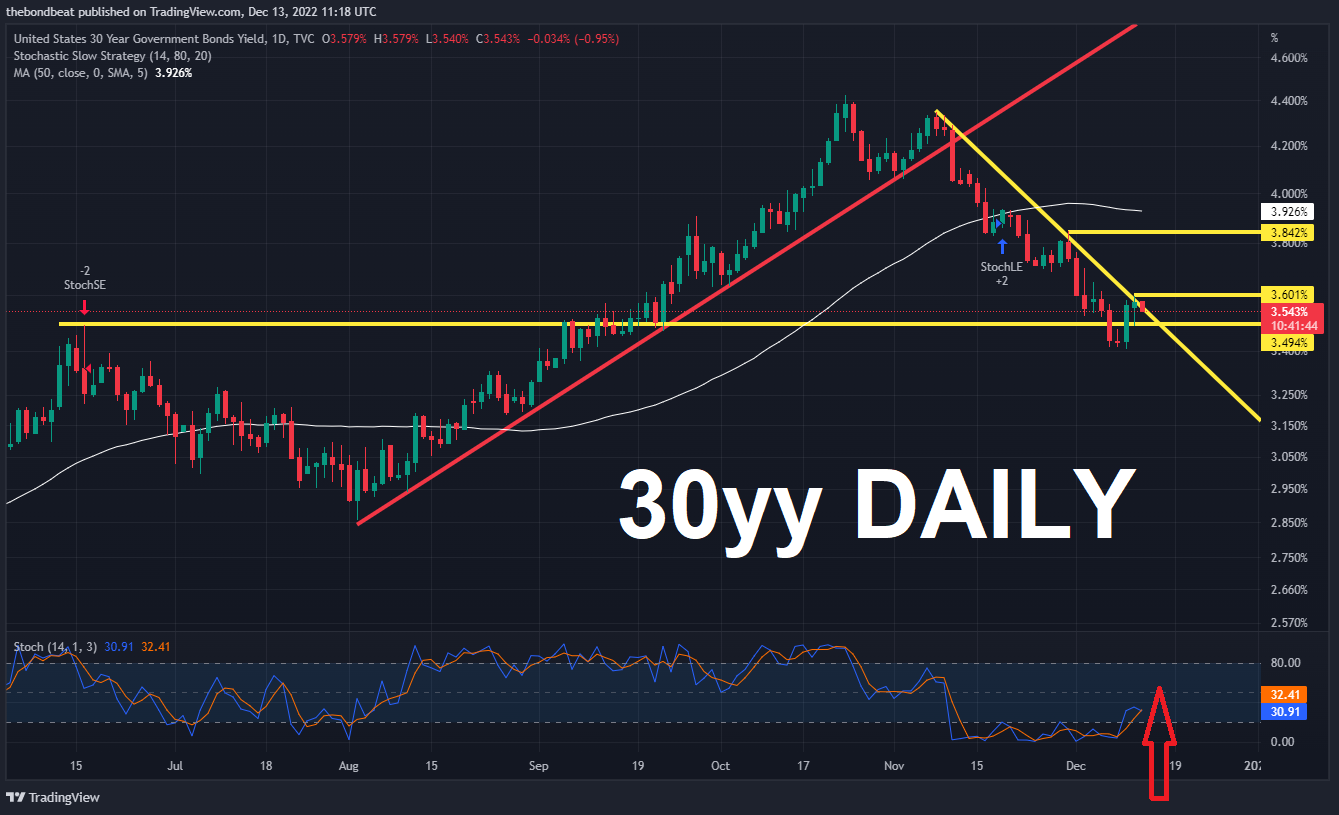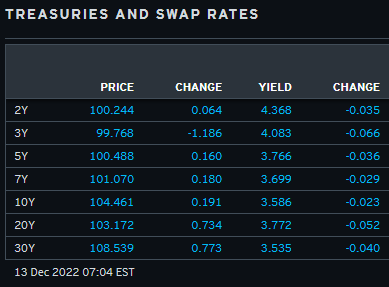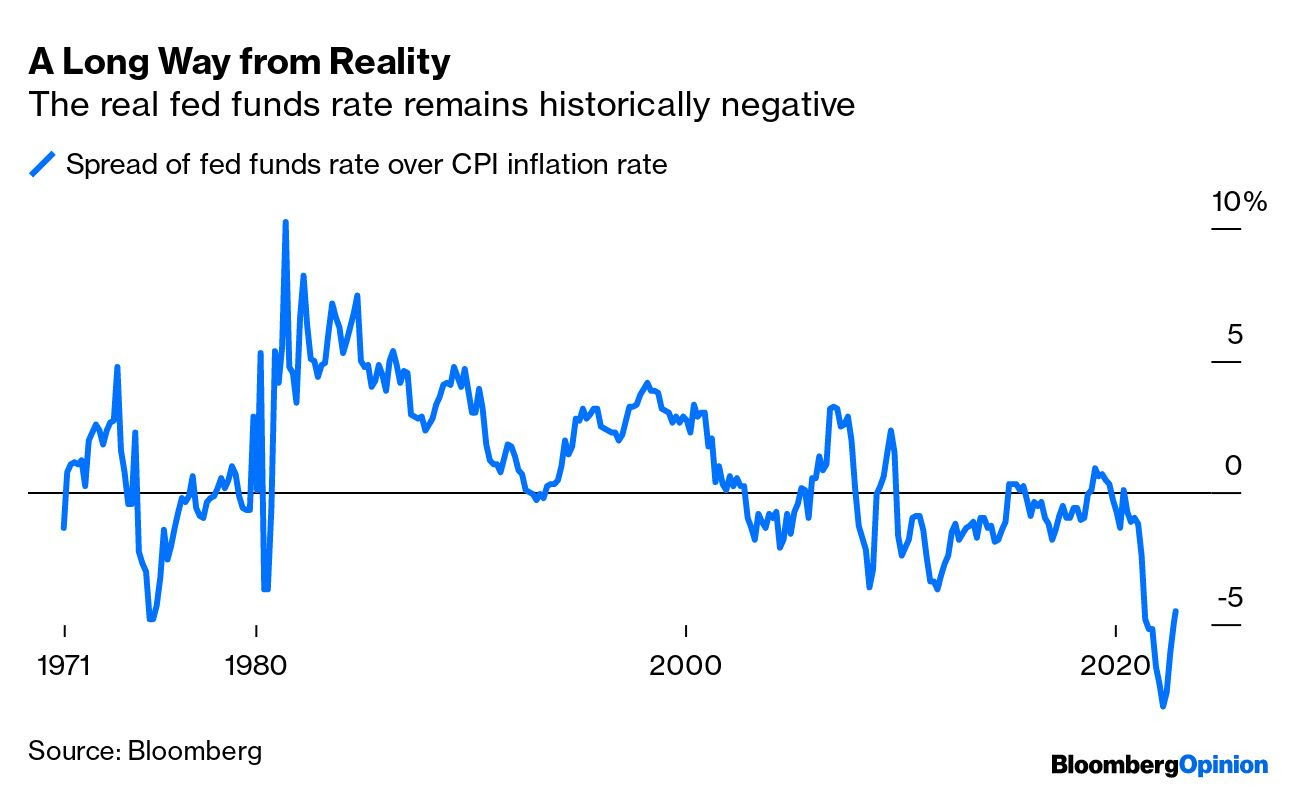(USTs modestly BID, flatter on about avg volumes)while WE slept; 'REAL' rates from 1870 - present
Good morning … CPI and long bonds today, FOMC decision and updated dot plots tomorrow … But first, a recap via ZH,
Stocks Panic-Bid Ahead Of CPI; Bitcoin, Bonds, & Bullion Dumped
And specifically about the UST markets current liquidity events,
ZH: Solid 3Y Auction Prices At Lowest Yield In 3 Months; Record Low Dealers
But wait, there’s MORE … um, LESS, I should say,
ZH: Pre-CPI Jitters Spawn Ugliest 10Y Auction In 6 Years
In as far as 10yy triangulating as it may / may NOT relate TO this afternoons final 30yr auction of 2022,
It would appear to ME that while similar TRIANGULATION pattern may exist, it is on verge of breaking in favor of further concession. Above 3.54% might bring 3.60% into focus but I’d say if we continue to leak ahead of the auction it will presumably be for a reason(s) — CPI and FOMC combined with the calendar and be DESPITE large short base … Note, then 3.70% area — series of lows middle / end of NOV.
Waiting. Watching and here is a snapshot OF USTs as of 704a:
… HERE is what the shop says be behind the price action overnight…
… WHILE YOU SLEPT
Treasuries are modestly higher and the curve flatter (2s30s -2.2bp) as markets await US CPI in a few hours. The news was pretty light overnight (save for Crypto space), DXY is lower (-0.2%) while front WTI futures are modestly higher (+0.5%). Asian stocks were mixed, EU and UK share markets are all in the green (SX5E +0.95%) while ES futures are showing +0.5% here at 6:50am. Our overnight US rates flows saw Treasuries firm during Asian hours, led by intermediates. Volumes were quite light though and our flow was largely focused on real$ selling in the long-end. Overnight Treasury volume (as of 6:45am) was still ~average overall after Tokyo colleagues reported ~60% of average volumes. So flows must have picked up during London's morning session...… Treasury 10yrs, weekly: 10yr yields have risen in each of the past three trading sessions as a short-term 'overbought' condition is getting worked off after 10's failed to hold below their resistance (~3.50%) derived by the twin yield peaks seen this past June. But this longer-term chart still looks bullish and still has us thinking that the recent sell-off is corrective rather than new trend-starting. Always defer to the prevailing [bullish] winds... as they say in the texts...
… and for some MORE of the news you can use » IGMs Press Picks for today (13 DEC) to help weed thru the noise (some of which can be found over here at Finviz). In some other news,
NY Fed 1-Year Inflation Expectations Plunge At Fastest Pace On Record To Lowest Since 2021
Now, ahead of this mornings CPI, a few items of interest. First from Jim EARLY MORNING Reid,
… Today we have the last in the series of another 2022 epic and that's the final US CPI to be released this year. Indeed, we don't get many days as important as the next two, and the US CPI today and the FOMC tomorrow are likely to be the difference between a big Santa Claus rally and a visit from Scrooge ahead of Christmas. Bear in mind the S&P 500’s best and worst day of the year so far have both come on a CPI day, and it was only last month that the downside surprise triggered a seismic market reaction, leading to the biggest one-day gain for the S&P 500 (+5.54%) since April 2020, and the largest daily decline in the 2yr Treasury yield (-24.7bps) since 2008. Since close of business the day before the last release the S&P 500 is +6.46%, 2yr yields -20.4bps, 10yr yields -49.6bps and the USD index -5.05%…
In as far as what to expect, BBG on the CONsensus,
… Anticipation for data releases don't get much bigger than for today's US CPI reading. With market consensus for a headline reading of 7.3% even after last week's producer prices reading damped the optimism. The range of forecasts is fairly tight, with 25 of the respondents to 49 economists surveyed by Bloomberg representing the mode, and the rest captured by a 0.3 percentage point range.
But just how accurate are these predictions? Seven out of 10 times, the economist hive-mind got the forecast within 20 basis points of the actual reading. A pretty impressive feat, given the complexity of the model estimating the reading (fun fact, it involves overlapping 32 geographic areas with 243 entry level items, creating a matrix of 7,776 combinations.)
Still, there's definitely scope for surprise. In the 11 readings delivered this year, headline hit median expectations just once, with the call too low on eight occasions, and too high on just two. And the hour after the release saw futures on the S&P 500 move more than 3% for three straight months. That's more than monthly jobs figure delivered in any recent reading. All in all, the excitement seems justified. Happy CPI Day.
Next up from BBGs John Authers,
Big Tech Stands In the Way of the Next Bull Market
… As a general rule of thumb, it’s been widely noted that past inflation spikes have never been vanquished until the federal funds rate exceeds the inflation rate. The market’s implicit bet is that inflation will drop in short order over the next few months, so that the Fed will have created a positive real fed funds rate that will endure for most of next year. This is not a fantasy; it’s plenty possible.
It’s still important to note just how extreme the gap between inflation and the fed funds rate has become. If we take a “real fed funds rate” by subtracting headline CPI from the fed funds rate, then we find that it is still more deeply negative than it had been at any time since 1971 — until the post-pandemic inflation took hold. Just to get back to a positive real rate will require a jolt as big as the one administered by the Fed under Paul Volcker at the turn of the 1980s:
We’ll have new numbers for both components of the real fed funds rate by Wednesday afternoon, and it would create a lot of reassurance if the line were nearer zero by then…
UBSs Paul Donovan looks at,
The three waves of US consumer prices
The Truth About Inflation is complex (interesting fact—the price of certain economic books remains completely unchanged). US November consumer prices are due today. The US 2021 transitory inflation was about durable goods. This inflation is largely over; it peaked at 18.7% y/y in February, and was 4.7% y/y in October—the most dramatic disinflation on record.
The second wave of US consumer prices was commodity driven. As commodity price changes have slowed, that has contributed less to the headline and core consumer price measure (commodities indirectly appear in core inflation).
The third wave is about profit expansion. Profits have grown faster than wages for seven of the past eight quarters, and at –4% real business compensation rates for workers are the worst on record. Resilient consumer demand (funded by savings and credit card borrowing) allowed firms to expand margins, and customers have been sold a story that the price increases are justified. There is anecdotal evidence that both demand resilience and consumer acceptance of price increases are fading…
Phases of TODAYS CPI report aside, here’s yet another dart thrown at the 2023 what will it be board …
AAM VIEWPOINTS — 2023 OUTLOOK — ASSET ALLOCATION IN THE NEXT PHASE OF THE REGIME CHANGE: STILL A MACRO-DRIVEN MARKET, INFLATION REMAINS IN THE DRIVER’S SEAT
… Fed Chair Powell is a student of history and understands these components. Therefore, we believe that hopes of a pivot lower are still too early and why we are in a “hike and hold” camp. Current market pricing shows the terminal funds rate topping at close to 5% and then reversing very shortly thereafter which we think is perhaps still too optimistic.
Market: “Praying for the Pivot” vs “Hike & Hold”
So, why would they hike and hold?
Inflation Remains in the Driver’s Seat
Our view remains that inflation will continue to decline but will linger for longer well above trend which pushes out the pivot. Why is that? Simply, the Fed can only destroy demand; it can’t solve some of the more pernicious drivers of inflation — the Fed can’t drill for oil, grow food, increase supply chains or stop deglobalization. The other big challenge leading to sticky inflation is wages. Wage gains are running north of 5% and are broadening across many industries. The labor shortage will be very difficult for the Fed to solve without causing a deeper recession, particularly with growing unionization, job hording, long Covid, early retirees and aging demographics. As such, it is not an unlikely scenario that the Fed stays put at the terminal rate longer and does not quickly pivot rather than go even higher and do real damage regarding its second mandate: a stable job market. As for the pivot, it must be maddening for the Fed when the market’s reaction to any hint of a pause or pivot causes financial conditions to ease, when they still have not completed the job! Powell, being astute to the lessons of history, seems to be signaling that he will be patient and thus push out the pivot, which is not priced in. Importantly, history also shows that once inflation gets going, even if it is coming down, it can remain above trend for years (four years on average):
History of Inflation: 6 Episodes — Inflation Above Trend for 4 years on Average
… Bottom Line: Keep patient, keep asset allocation focused on resiliency, quality, value and income generation. We do not believe what worked the past 10 years is necessarily the right formula for the next 10 years in the new regime.
From year ahead to the WEEK just ahead … here are some global MACRO thoughts from a large British operation,
Still holding up
The bond rally and oil swoon of Q4 implies that economies are slowing faster than expectations. The opposite is true, especially after China’s decision to relax zero Covid curbs. With the global economy still holding up, we recommend paying short US rates, and believe the oil sell-off is unjustified by fundamentals.
With friends like this economic data ‘still holding up’, who needs enemies?
Following up on AAMs idea of what worked in the past years NOT necessarily working into the future, I’m going to end with one final link … I ALWAYS say and think I do not have to be smartest in the room simply know who is.
Carmen Reinhart is one of those and penned THIS in Project Syndicate
Will Central Banks Do What It Takes?
Dec 11, 2022CARMEN M. REINHARTFew would doubt that, after 15 years of ultra-low interest rates, reining in inflation by restoring real positive rates will be difficult. And with 2023 expected to bring heightened global financial and economic risks, monetary tightening will almost certainly become even more complicated.
… A historical perspective illuminates some of the challenges that are likely to emerge as international financial conditions tighten. Real policy interest rates (nominal interest rates minus inflation) in the world’s financial center, the United States, have been consistently negative since the 2008-09 global financial crisis.
Real interest rates have remained negative for multiyear periods in a global financial center only four times since the mid-1800s (at least). The first three episodes were during the two world wars and in the aftermath of the OPEC oil shock from 1974-1980. In these three cases, average inflation in the US ranged from 7% to 15%, and the restoration of positive real interest rates was part of an effort to tackle inflation.
… Central-bank independence seems to have eroded – not necessarily de jure, but possibly de facto, as officials weigh the broader consequences of their actions. If leverage (public and private) and risk exposures raise doubts about financial stability, will central banks return to accommodation? What if fears of a market crash emerge, or sovereign insolvencies seem imminent (as might occur in the eurozone)? In the 1970s, economies endured years of high inflation before the exit from negative real interest rates was complete.
And yet more risks loom in 2023. China – a key engine of global economic growth after the last global financial crisis – is grappling with financial and political fragilities. Tighter global financial conditions could severely damage emerging-market and developing economies in the short run. Those with large US-dollar-denominated debts will suffer even more. Already, more than 60% of low-income countries are either at high risk of distress or already there.
But just as the exit from the “low-for-long” interest-rate era raises grave risks, so, too, does persistent high inflation, which, among other things, exacerbates inequality within and across countries. To say that this is a challenging time for governments and central banks would be a massive understatement.
… THAT is all for now. Off to the day job…










